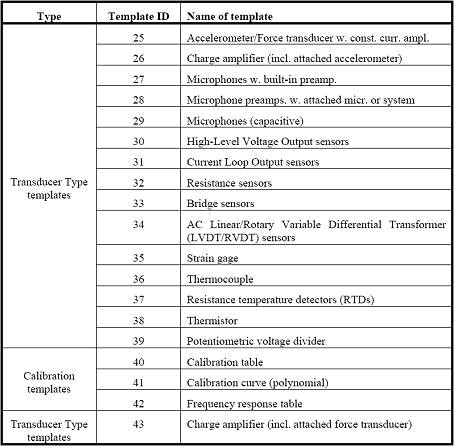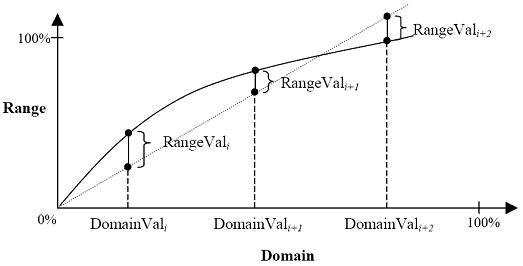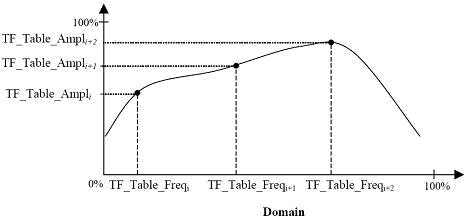Labview Reading Usb Connection From Teds Sensor
The data stored in the sensor's EEPROM or a VTEDS file is compressed to relieve infinite. To retrieve and interpret the data, the DAQmx driver applies a template to the binary data. There are separate templates for each blazon of sensor from charge amplifiers to thermistors. In addition to these sixteen standard templates, there are three scale templates: a calibration table, calibration curve (polynomial), and frequency response table. See Table i below.
Table one. IEEE 1451.4 Standard Templates

The calibration table template describes a lookup tabular array with the electrical-to-physical transfer part of a transducer. The table requires multiple sets of values for the CalPoint_DomainValue and CalPoint_RangeValue parameters. See Table 2 below.
Table 2. Scale Tabular array Template (ID = twoscore) Summary

CalTable_Domain is used to select the domain parameter for the calibration table as either electric (0) or physical (i). For example, an electrical domain parameter would be voltage, whereas a concrete domain parameter would Celsius. CalPoint_DomainValue is the domain parameter for the calibrated value, expressed as a percentage of the full range of the transducer. If a thermocouple has a full range of -300 to 300°C, then CalPoint_DomainValue would exist 50% if the thermocouple were to be calibrated at 0°C. CalPoint_RangeValue is the deviation of the range measurement from the expected value, expressed equally a percentage of the total range of the transducer. A reading that is off by 5°C would correspond to a CalPoint_RangeValue of .8333% for the aforementioned thermocouple. Effigy 1 below illustrates the use of these properties to specify the transfer office of the transducer.
Effigy i. Scale Table Transfer Function

The calibration table template provides a simple means of recording a few data points for calibration purposes. This is especially useful when calibrating around a very narrow range of values.
Sometimes, however, it is necessary to precisely narrate a transducer over its entire range. This may show difficult, especially in the case of a transducer with a highly nonlinear transfer function, such as a thermocouple. Accordingly, TEDS provides an alternative means of calibration. The calibration curve template specifies a multi-segment polynomial curve describing the electric-to-physical transfer role of a transducer. Come across Tabular array iii beneath.
Table 3. Calibration Bend Template Template (ID = 41) Summary

The overall function is described in a piecewise manner, each segment defined by an array of coefficients and powers. For case, a curve may exist described by [(three,1),(2,5),(1,-2),(0,1)], where the numbers in parentheses are interpreted every bit (CalCurve_Power,CalCurve_Coef). This would interpret to the polynomial role f(x) = x3 + 5x2 – 2x + 1. Meet Figure two below.
Figure 2. Calibration Bend Transfer Function


![]()
due north thou =___ C k,i =___ P k,i =___
the number of coefficients for segment k, read from the TEDS as CalCurve_Poly the ith polynomial coefficient for segment k, read from the TEDS every bit CalCurve_Coef the power to which domain variable 10 is raised for coefficient Cm,i in segment k
Each segment of the function is delineated by the CalCurve_PieceStart parameter, which specifies the starting value of each slice. Each segment is bounded by sequential values of CalCurve_PieceStart, airtight below and open up in a higher place. For example, the segment k interval in the figure above includes CalCurve_PieceStart k only excludes CalCurve_PieceStart k+1, where PieceStart one thousand designates the k th value read for the CalCurve_PieceStart property. This segment is one of potentially several polynomials that may describe the transfer function of a transducer. Many RTDs, for example, exhibit linear beliefs for role of their measurement range, and polynomial for the remainder.
To make effective use of the calibration curve template, several calibration points must be taken and then fitted to a polynomial curve. This may accept significantly more time than collecting a few information points for a scale table. However, the tradeoff is greater accuracy and a wider range of calibrated values.
Some measurements may require information beyond the fourth dimension domain. The frequency response transfer function of a transducer is particularly useful for microphones and accelerometers. The frequency response of any vibration transducer, in fact, is very of import when comparing readings. Sensors with a broader frequency response volition run into more vibration if information technology is nowadays than a narrower bandwidth transducer.
The frequency response table template specifies the frequency response transfer function of a transducer with a lookup table of frequency-amplitude pairs. Like to the CalTable and CalCurve properties, TF_Table_Freq and TF_Table_Ampl define information points in the amplitude-versus-frequency transfer office. Encounter Table iv and Figure three below.
Table 4. Frequency Response Table Template (ID = 42) Summary

Figure 3. Frequency Response Transfer Office

Any combination of these calibration templates may be used; however, each is tailored to a different type of measurement. Calibration tables offer an easy means of thoroughly characterizing a narrow range of transducer readings. Scale curves completely specify the range of transducer, though they require more try due to the calculation of a polynomial from detached measurements. Frequency response tables may exist combined with either of the kickoff two templates to provide more information about the dynamic response of a transducer.
troutonlamenscaught.blogspot.com
Source: https://www.ni.com/en-id/support/documentation/supplemental/06/sensor-calibration-with-teds-technology.html
0 Response to "Labview Reading Usb Connection From Teds Sensor"
Post a Comment